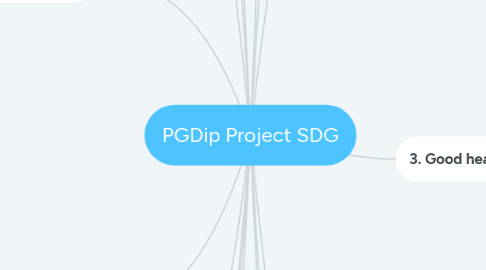PGDip Project SDG
por Ivan v Antwerpen


1. 4. Quality education (SG)
1.1. Government Policies
1.2. Educator/Learner Ratios
1.3. Inequalities in Facilities
1.4. Poverty
1.5. Past Regimes
1.6. Corruption in Administration
1.7. Ineffective Service Providers
1.8. Geographical factors
1.9. Quality and Quantity of Educators
1.10. Past Regimes
1.11. Ageing Workforce
2. 14. Life Below Water (WS)
2.1. Pollution (waste, mercury, plastic)
2.2. Wastage of water
2.3. Over fishing
2.4. Carbon emissions destroying life under water
2.5. Desalination
2.6. Poaching rare/ specific species
3. 1. No Poverty (IVA)
3.1. Unemployment
3.2. Inflation
3.3. Poor management of resources
3.4. Government policies
3.5. Under-Education
3.6. Debt
3.7. Corruption
3.8. Lack of control in local food
3.9. Lack of access to education
3.10. Mental illness - lack of proper psychiatric care
3.11. Epidemic diseases
3.12. Automation - Technological Unemployment
3.13. Over Population
4. 2. Zero Hunger (IVA)
4.1. Climate
4.2. Water shortages
4.3. Genetically modified seeds
4.4. Labour
4.5. Population growth
4.6. Land utilization
4.7. Funding
4.8. Expensive farming methods
4.9. Inefficient farming practices
4.10. Resource intensive farming practices
4.10.1. Urban hydroponic farming and management
4.11. Knowledge on farming practices
5. 3. Good health and well-being (AL & IVA)
5.1. Poverty
5.2. Education and Awareness
5.3. Public Healthcare programs
5.4. Access to Healthcare Institutions
5.5. Cost Effective Medical Supplies
5.6. Poor Sanitary Conditions
5.7. Social Support Systems*
5.8. Prevention of new infections of communicable diseases
5.8.1. HIV
5.8.2. STIs
5.8.3. Flu
5.8.4. TB
5.9. Better treatment of diseases
5.10. Early detection of non communicable diseases
5.10.1. Awareness
5.10.2. Access to healthcare
5.11. Prevention of diseases
5.11.1. Excercise
5.11.2. Regular health checks
5.11.3. Diet
6. 5. Gender equality (SG)
6.1. Established belief systems
6.2. Culture and traditional beliefs
6.3. Previously male dominated disciplines
6.4. Ecologies
6.5. Religion
6.6. Economies
6.7. Socialization
6.8. Biology
6.9. race, class, sexual orientation, historical period
6.10. Natural arrangements for family requirements and raising children
6.11. Bad mentality
6.12. Education level
6.13. Empowerment
7. 6. Clean Water and Sanitation (AL)
7.1. Inadequate sanitation
7.2. Water shortages
7.3. Pollution by big companies
7.4. Poor communities - waste runoff into water streams
7.5. Infrastructure - old pipes, pipe network cannot reach far out communities
7.6. No direct water supply into homes - communal taps
7.7. Bucket system
7.8. Shared toilets - informal settlements
7.9. Dirty water - Madibeng; Temba/ Hammanskraal
8. 7. Affordable and Clean Energy (RB)
8.1. Expensive energy generation methods
8.2. cheapest energy is "dirty"
8.3. High cost of delivering energy to poor communities
8.4. Unemployment
8.5. Polluting energy sources
8.6. Renewable energy is expensive or perceived so (Emetere et al.)
9. 8. Decent Work and Economic Growth (RB)
9.1. Lack of proper education
9.2. Lack of external investments
9.3. political unrest
9.4. poor economic policies
9.5. poor governance
9.6. poor leadership in public and private sectors
9.7. Trade Openness (Akinwale)
9.8. Unemployment
9.9. Infrastructural Investment/development
9.10. Saving & Investment
10. 9. Industry, Innovation and Infrastructure (JK)
10.1. resilient infrastructure
10.2. sustainable industrialization
10.3. access of small-scale industrial and other enterprises
10.4. upgrade infrastructure
10.5. Enhance scientific research
10.6. enhanced financial, technological and technical support
10.7. Support domestic technology development
10.7.1. Building of Bill of rights Chat bot tamagotchi in rural areas
10.8. Significantly increase access to information and communications technology
10.8.1. Alexa for South Africa
11. 10. Reduced Inequalities (AL)
11.1. Entrenched patriarchy
11.2. Racial prejudice
11.3. Unemployment
11.3.1. Low economic growth
11.4. Minimum vs living wage
11.5. Education linked to high growth/ need industries
11.6. Corruption - misused resources
11.7. Social inequaities
11.7.1. Access to good quality health care
11.7.2. Access to quality education
11.7.3. Access to quality education
11.7.4. Access to sanitation (including school pit toilets)
11.7.5. Mud schools
11.7.6. Access to technology - connectivity - consequent ability to look for opportunities
11.8. Equal opportunities for the disabled in practice
12. 11. Sustainable Cities and Communities (SG)
12.1. Lack of Automation
12.2. Geographical dispersion and disparity
12.3. Lack of affordable or free internet connectivity
12.4. Access to safe and efficient transport
12.5. Economy, mobility, security, education, living and environment.
12.6. Efficient Resource Allocation
13. 12. Responsible Consumption and Production (CM)
13.1. Sustainable Farming Practice
13.2. Water Management
13.3. Land Management
13.4. Reduce CO2 Emissions
13.5. Technology (Drones)
13.6. Going Green
13.7. ZERO Plastic
13.8. Efficient use of natural resources
14. 15. Life on Land (CM)
14.1. Deforrestation
14.2. Preservation of inland water systems
14.3. Animal Poaching
14.4. Biodiversity
14.5. Alien plant species
15. 17. Partnerships for the Goals
16. 16. Peace and Justice (JK)
16.1. reduce violence and related deaths
16.2. End abuse, against kids
16.3. Promote the rule of law
16.4. reduce illicit financial and arms flows
16.5. reduce corruption
16.6. transparent institutions
16.7. representative decision-making
16.8. participation of developing countries in the institutions of global governance
16.9. legal identity
16.10. Ensure public access to information and protect fundamental freedoms
16.10.1. Bill of Rights Chat bot in all official languages. Concerns requires a smart phone. Bill of rights chat bot tamagotchi?
